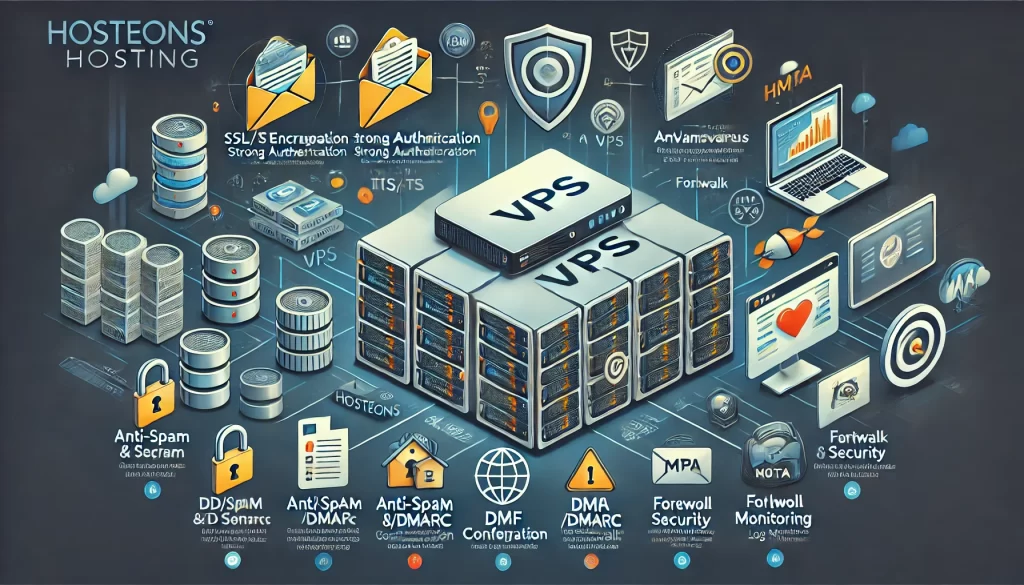
Running your own email server on a Virtual Private Server (VPS) offers increased control, privacy, and customization compared to third-party email services. However, with greater control comes the responsibility to secure your server from threats like spam, data breaches, and unauthorized access. In this article, we’ll cover the best practices for setting up and maintaining a secure email server on your VPS.
1. Use Strong Authentication and Secure Credentials
- Strong Passwords: Ensure that all email accounts use strong, complex passwords. Consider implementing password policies that enforce minimum length, character diversity, and expiration periods.
- Two-Factor Authentication (2FA): If supported, enable 2FA for accessing email server administration panels and webmail interfaces to add an extra layer of security.
2. Use Secure Protocols (SSL/TLS)
- Enable TLS Encryption: Configure your mail server to use STARTTLS for encrypting communications with email clients and other servers. This helps protect data during transmission.
- Install an SSL Certificate: Obtain a valid SSL certificate from a trusted Certificate Authority (CA) and install it on your email server. This ensures that your email clients can securely connect to the server without warnings.
- Disable Unencrypted Connections: Ensure that plaintext connections (non-SSL/TLS) are disabled to prevent potential eavesdropping.
3. Configure Anti-Spam and Anti-Virus Filters
- SpamAssassin: Consider using SpamAssassin or similar anti-spam software to filter out unwanted and malicious emails.
- ClamAV: Use an antivirus solution like ClamAV to scan incoming and outgoing emails for viruses, malware, and other malicious attachments.
4. Implement Rate Limiting and IP Blacklisting
- Rate Limiting: Set limits on how many emails a user or domain can send per hour/day to prevent spamming and abuse.
- IP Blacklisting: Use dynamic IP blacklists to block known sources of spam and malicious traffic. Configure tools like Fail2Ban to detect and ban suspicious IP addresses based on authentication failures.
5. Use Secure Ports and Firewall Rules
- Configure Ports Correctly: Use the following ports for secure email traffic:
- IMAP over SSL/TLS (IMAPS): Port 993
- POP3 over SSL/TLS (POP3S): Port 995
- SMTP over SSL/TLS (SMTPS): Port 465
- SMTP with STARTTLS: Port 587
- Set Up Firewall Rules: Use iptables or a firewall management tool like UFW to allow only the necessary ports for email traffic while blocking all other unnecessary traffic.
6. Enable DKIM, SPF, and DMARC
These email authentication protocols help ensure that emails sent from your domain are legitimate, reducing the chances of spoofing and phishing:
- DKIM (DomainKeys Identified Mail): DKIM adds a digital signature to your emails, proving that they originated from your domain.
- SPF (Sender Policy Framework): SPF specifies which IP addresses are authorized to send emails on behalf of your domain.
- DMARC (Domain-based Message Authentication, Reporting & Conformance): DMARC ties together SPF and DKIM, providing instructions to email servers on how to handle messages that fail authentication.
7. Secure the Mail Transfer Agent (MTA)
- Use Secure MTAs: Ensure that your mail server software (such as Postfix or Exim) is securely configured. Disable open relays to prevent your server from being used as a source of spam.
- Enforce Authentication for SMTP: Require users to authenticate before sending email to prevent unauthorized access and abuse of your server’s resources.
8. Regularly Update and Patch Your Server
- Apply Security Updates: Regularly update your email server software, operating system, and any related packages to protect against known vulnerabilities.
- Automate Updates: Where feasible, consider automating security updates to reduce the risk of delayed patching.
9. Monitor Logs and Security Events
- Log Review: Regularly review email server logs for signs of unusual activity, such as repeated login failures or high volumes of outgoing messages.
- Monitoring Tools: Use tools like Logwatch or Graylog to monitor and analyze logs for suspicious behavior in real-time.
10. Enforce Mailbox Quotas and Archiving Policies
- Mailbox Quotas: Set limits on mailbox sizes to prevent a single user from consuming excessive resources.
- Email Archiving: Implement policies for archiving old emails, reducing the amount of active data and improving server performance.
11. Consider Using Web Application Firewalls and Intrusion Detection Systems
- WAFs and IDS: Use tools like ModSecurity (web application firewall) or Snort (intrusion detection system) to protect against malicious web traffic and detect attacks on your server.
12. Backup Your Server Regularly
- Automated Backups: Implement a robust backup solution to regularly back up email data, configurations, and critical server files.
- Offsite Backups: Store backups offsite or on a separate server to ensure data can be recovered in case of a major incident.
Conclusion
Running a secure email server on your VPS requires diligence, ongoing monitoring, and a robust set of security measures. By following these best practices, you can ensure that your email server is protected against common threats, provides reliable communication, and maintains your user’s trust. Hosteons.com offers reliable VPS solutions to give you the control and performance you need for running your email server securely and efficiently.
Ready to set up a secure email server on Hosteons.com VPS? Get started with our reliable and scalable VPS plans today!